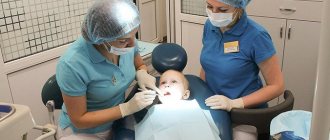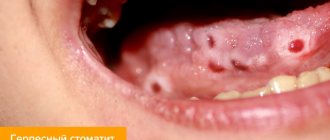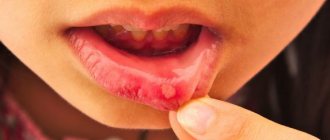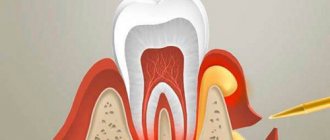Treatment of gums in children is a common reason for visiting a dentist. The susceptibility of delicate gums to inflammatory processes is explained by their sensitivity to all kinds of damage and poor hygiene. The remaining soft plaque on the teeth eventually turns into hard deposits in the form of tartar. Inflammation can also be caused by an infection that enters the oral cavity through dirty toys, for example. Unfortunately, parents are not always able to monitor the regularity and quality of brushing their children’s teeth or protect them from licking dirty surfaces.
Inflammation of the mucous membrane of the gums or gingivitis must be detected as early as possible and treatment begun. This is why regular scheduled examinations are so important. A delay in making a visit can result in a complication - there is a risk of transition to a chronic form, after which - to the ulcerative-necrotic stage, and, as a result, damage to surrounding tissues. Periodontitis is one of the most serious stages of gum disease.
Teething in infants is not only a painful process, but also provokes inflammation of the gums, as well as injuries, as a result of diligently sucking a rattle or a cracker offered by the mother...
Causes of gum inflammation in children
- Skipping or poor quality teeth brushing;
- Sucking dirty objects;
- Errors when installing seals;
- Pathologies of the dentition;
- Carious cavities with sharp edges;
- Bite correction;
- Breathing through the mouth;
- Abnormal structure of the oral cavity organs (attachment of the frenulum of the tongue and lips);
- Problems with the functioning of the cardiovascular system;
- Disruption of the gastrointestinal tract;
- Infectious diseases (ARVI, influenza);
- Hormonal abnormalities;
- Hereditary anomalies.
Types of inflammatory processes
Gingivitis
Inflammation of the gums at the initial stage, that is, not yet spreading to the bone tissue, is called gingivitis.
Treatment of gingivitis in children follows the same principle as in adults, with the only difference being that children are prescribed more gentle medications. When starting the procedure, the hygienist performs professional cleaning, removing plaque and stone, after which he teaches the little patient proper hygiene techniques. Helps you navigate the selection of toothpaste and brush.
Periodontitis
Inflammation of the gums and periodontal tissues - periodontitis - is an advanced stage of gum disease. If left untreated, its progression may result in one or more teeth having to be removed.
Treatment includes occupational hygiene and physical therapy. If the process is advanced, surgical intervention may be required.
Periodontal disease in children
The defeat of all periodontal tissues, in this case, is called childhood periodontal disease. This degree is quite rare. Progression can be triggered by weakened immunity and vitamin deficiency.
An effective option in this case is surgical intervention, as well as strengthening the general condition of the body.
Stomatitis in children
Infectious inflammation of the mucous membrane of the gums, or stomatitis, is characterized by increased sensitivity and discomfort while eating. Therefore, you should show it to a dentist as soon as possible. A dental clinic specialist will examine the baby and prescribe appropriate procedures.
Causes of Teething Cysts in Children
During teething, a hematoma is formed; it occurs due to the fact that the tooth cannot break through the mucous membrane and thereby injures the gums and ruptures blood vessels. The longer the formation is in the oral cavity, the larger its size; in addition, the amount of swelling will depend on the group affiliation of the tooth.
The main causes of the tumor:
- pulpitis;
- caries;
- periodontitis;
- improper tooth treatment or lack thereof;
- eruption injuries.
The baby’s body tries to limit the source of infection, which is why a dense protective capsule is formed, which eventually develops into a cyst. The occurrence of such formations is quite common. An infection caused by carelessness, an unsuccessful attempt to chew hard food, a fall that led to a tooth injury - all this can serve as a starting point for gum inflammation and further development of a cyst.
Another fairly common mistake parents make, which can lead to the appearance of a tumor during teething, is negligence in caring for baby teeth.
It is generally believed that you should take serious care of your dental health after changing them. Since there is no point in treating non-permanent baby teeth - they will soon fall out. In fact, not taking things seriously leads to many problems. Any gum diseases and oral infections should be eliminated in a timely manner, regardless of how many teeth the baby has and whether they are permanent or not.
Gum atrophy
A rather unique and rare disease - gum atrophy or exposing atrophic gingivitis manifests itself as itching in the area of 2, less often 4 and 6 symmetrically located milk teeth. A child experiencing discomfort constantly rubs the area of inflammation. At night, the itching usually intensifies.
The interdental papillae and other areas of the gums do not change in any way during gingival atrophy. Slight deposits of tartar are often observed on the unprotected root surface.
The manifestation of itching can be a consequence of measles or influenza, despite the fact that in most young patients such a relationship is not observed. The process of teething is also one of the factors causing itching in infants.
Diagnosis of gum disease in children
A routine oral examination should be performed by a pediatric dentist every six months. And as necessary, if a small patient exhibits any deviations in the development of teeth or symptoms of disease of the oral mucosa. Since it is advisable to diagnose the inflammatory process at the earliest stage.
If redness, swelling and bleeding are detected, the cause of which is an excessive amount of soft plaque or food debris on the teeth, the dentist will make a diagnosis and prescribe procedures.
If a bacterial infection is suspected, a clinic specialist can take biomaterial from the inflamed areas of the gums for clinical tests. Based on the results of the analysis, the specialist prescribes a treatment plan and the date of the next appointment to ensure the final recovery of the little patient.
Cyst treatment
A dental cyst is treated either with therapeutic methods or with surgical intervention. The first ones are used in simple cases.
Surgery involves two types of operations - cystotomy and cystectomy. In both cases, local anesthesia is used. With cystomy, only the anterior wall of the cyst is removed. This is a less traumatic option, as it allows you to preserve the rudiments of permanent teeth during surgery on milk teeth.
Cystectomy is performed if the size of the cyst does not exceed 1.5 cm. This operation is more difficult, but postoperative recovery is much faster.
No matter how small and insignificant the swelling may seem to you, contact your dentist. This will avoid complications. And the problem will be resolved more easily and in a short time. Remember that no rinses, infusions or other folk remedies can guarantee recovery.
Treatment of gums in children
Medicines prescribed by a doctor have analgesic, antibacterial and anti-inflammatory effects. They help restore the proper condition of the mucous membrane. Methods of using drugs are different, but the principle is the same: rinsing, irrigation.
For gum disease in infants, the dentist will prescribe special gels to relieve symptoms, namely itching and pain. Parents should pay special attention to cleaning their mouths from food debris.
Antibiotics are prescribed by a dentist in rare cases. Indications for the use of antibiotics is a form that reaches a complex (ulcerative-necrotizing gingivitis) or chronic stage. Antibacterial or antifungal drugs are prescribed when the problem is caused by an infectious process, and the goal is to eliminate its causative agent.
Types of gingivitis
The disease can progress differently, depending on the type of gingivitis. Treatment is prescribed by a doctor individually in each specific case.
Important. The acute form of the disease is much more common in children. The chronic form occurs in the absence of treatment.
Classification
The disease is classified according to several criteria:
- zone of distribution - local (one interdental papilla is inflamed) or generalized (most of the gum is inflamed) gingivitis;
- nature of the course - acute or chronic stage;
- the degree of change in the mucous membrane of the gums - catarrhal, ulcerative, hypertrophic, atrophic, marginal, desquamative.
According to the severity of the disease, three forms are distinguished - mild (damage to one or two interdental papillae), moderate (inflammation of the gum edge), severe (damage to most of the gum).
Catarrhal
Acute catarrhal gingivitis is most often diagnosed during teething or changing teeth, as well as against the background of previous infectious diseases.
Characteristic features:
- severe redness and swelling of the affected areas;
- discomfort in the gums, pain, itching, bleeding of the gums when brushing teeth or eating;
- bad breath;
- low-grade fever.
There is a feeling of malaise, but the general condition is not cause for concern.
Marginal
It usually occurs in childhood and indicates poor oral hygiene. It goes away immediately in a chronic form, another name for the disease is “dirty” gingivitis. It manifests itself in bleeding gums, usually when brushing your teeth. The marginal tissues are swollen, hyperemic, with a cyanotic tint. Treatment consists of removing plaque and following oral hygiene rules.
Desquamative
The main feature of desquamative gingivitis is epithelial sloughing. The affected areas are also distinguished by increased redness in the form of individual spots. In the initial stage, the disease does not cause concern, but later, in the absence of treatment, the mucous membrane becomes loose, pain and burning in the gums appear, and erythema spots grow. When neglected, blisters with yellowish contents appear in place of the spots, then ulcers form in place of the blisters. At the same time, sleep is disturbed, headaches and irritability appear.
Important. Desquamative gingivitis occurs cyclically with sudden exacerbation without provoking factors. Remission is long-term, up to two years.
Hypertrophic
The second name is hyperplastic. The disease is typical for prepubertal and pubertal age and is associated with the influence of sex hormones on gum tissue at this particular age. In the fibrous form, there is an overgrowth of the papillae, the gums are greatly enlarged and partially cover the teeth. The edematous form is more severe - the gums are enlarged and hyperemic. When brushing your teeth and chewing food, the pain and bleeding noticeably intensify.
A dental examination reveals severe gum overgrowth, looseness and swelling of the gingival papillae, and the presence of false gum pockets. Also, a distinctive feature of hypertrophic gingivitis is a significant amount of plaque on the teeth.
Ulcerative
The ulcerative form is the next stage of catarrhal gingivitis against the background of decreased immunity after influenza, acute respiratory viral infections, infectious diseases, and herpetic stomatitis. Another reason is hypothermia.
Characteristic symptoms:
- hyperemia, swelling, bleeding gums;
- the appearance of ulcers;
- general weakness, low-grade fever;
- bluish tint near the gums.
In the absence of adequate therapy, the disease passes into the ulcerative-necrotic stage - the ulcers are covered with a gray-green coating, a putrid odor from the mouth appears, and saliva becomes viscous. Sleep and appetite disturbances are observed, the child becomes capricious.
Atrophic
In most cases, the disease is chronic and is detected during examination by a dentist. It is observed in case of improper filling of teeth, in the presence of congenital defects of the frenulum of the tongue, or in case of malocclusion.
Symptoms – not clearly expressed:
- slight bleeding gums;
- exposure of tooth roots;
- reduction in gum volume.
In the initial stage, there are no inflammatory signs or pain, the gums are not hyperemic. Then, with the gradual exposure of the roots of the teeth, discomfort and pain appear when eating hot or cold food. In the absence of treatment, progressive dystrophic changes in the gingival margin are observed.
Preventive actions
The best prevention of inflammation of the mucous membrane is daily and high-quality hygiene from an early age and proper nutrition.
Hygiene
The concept of “quality hygiene” includes brushing your teeth at least twice: in the morning and in the evening, in conjunction with cleaning the palate and tongue.
Parents should take a very responsible approach to hygiene from the day the first tooth appears. And after he grows up a little, learn the rules of brushing his teeth: regularly and efficiently. The toothbrush and toothpaste should be selected according to the age of the small patient.
Nutrition
In addition to hygiene, parents need to approach the diet wisely: it should be balanced and include vitamins and minerals. Sweets and carbonated drinks should be consumed by the child in limited quantities. In addition, after finishing eating sweets, the baby should rinse his mouth with water and, if possible, brush his teeth. Note that a diet that promotes the proper development of a growing body includes nutritious and timely meals. Snacking and disordered eating should be kept to a minimum.
What to do if you suspect gingivitis?
If, during examination of the oral cavity, you find redness and swelling of the gums, you should:
- make an appointment for your child with the dentist in the near future;
- if the baby has a fever, give him an antipyretic drug in accordance with his age;
- if you complain of pain, treat the gums with a 0.25% solution of potassium permanganate, a 3% solution of hydrogen peroxide in the form of irrigation or rinsing. These are temporary measures, they are not a treatment for gingivitis, but will simply relieve swelling and pain a little;
- take your child to the dentist.
Remember that oral hygiene and a healthy lifestyle are the key to strong teeth and healthy gums for your child!
Treatment of children at RAIDEN
In the RAIDEN network of dental clinics, the treatment and prevention of oral diseases of young patients is treated with the utmost attention and reverence - the health of the younger generation is very important to us!
All medications used in our clinic meet the highest quality requirements. Before using them, we conduct a blood test of the baby to determine drug tolerance. The safety of your children, our little patients, is paramount to us.











